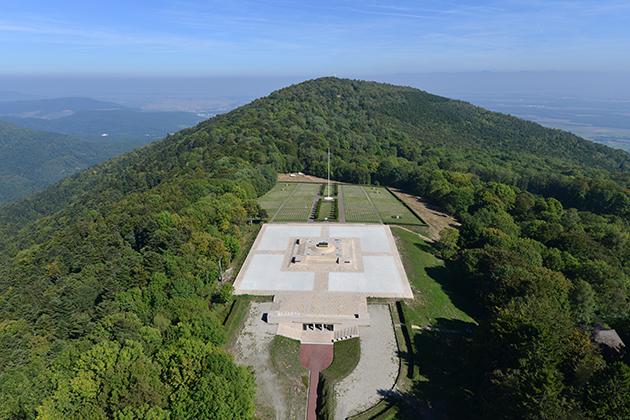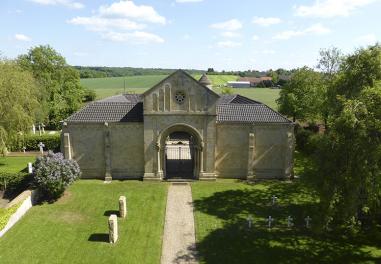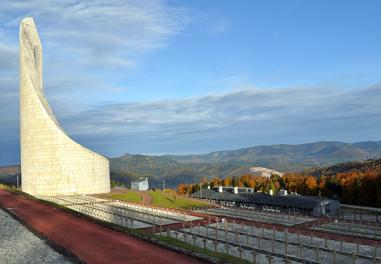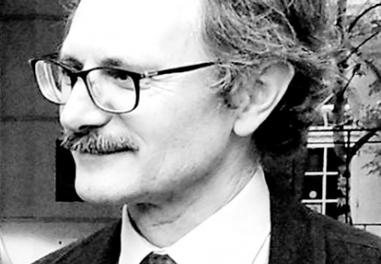The Historial Franco-Allemand, Hartmannswillerkopf
On 3 August, the first Franco-German museum of First World War history, the Historial Franco-Allemand de la Grande Guerre, will open in Hartmannswillerkopf, Alsace. The perfect opportunity for Chemins de la Mémoire to look back at the history of the site.

On 3 August, the first Franco-German museum of First World War history, the Historial Franco-Allemand de la Grande Guerre, will open in Hartmannswillerkopf, Alsace. The perfect opportunity for Chemins de la Mémoire to look back at the history of the site.
In a few weeks’ time, six years after the project was launched, visitors to the historic site of “Le Vieil Armand”, as it was nicknamed by French troops during the First World War, will find a brand-new learning and remembrance space: 85 years after the official opening of the national monument, Hartmannswillerkopf will become home to the first ever Franco-German museum of First World War history. Funded by the Ministry of Defence, the museum intends to offer a new perspective, at once French and German, on the history of the bitter fighting that took place in the region, celebrate Franco-German reconciliation and friendship – which take on their full meaning in a territory like Alsace – and raise awareness about the conflict among the younger generation. A complete cultural season will accompany the opening of the museum, one highlight of which will be the temporary exhibition Vivre en temps de guerre - Menschen im Krieg (Life in wartime), organised by the Haut-Rhin Departmental Archives and the Karlsruhe Generallandesarchiv.
THE SCENE OF VIOLENT FIGHTING IN WW1
The Vosges mountains were the scene of one of the toughest battles of the First World War. In December 1914, attacks took place across the Vosges, France’s only mountain front, with French and German troops digging in opposite one another in miles of trenches. The objectives were simple: to take the high ground in order to have control of the valleys and transport routes. Among that high ground was Hartmannswillerkopf, a 956-metre summit which dominated the plain of Alsace. On 21 December 1915, nearly 350 000 shells were fired. In one year, some 25 000 French and German soldiers were killed, wounded or went missing in the Battle of the Vosges, a precursor of the major offensives of 1916. Hartmannswillerkopf, which soldiers nicknamed the “man-eater”, made a particular kind of static warfare of this fighting in the mountains which subjected the men to extremely harsh living conditions, the cold and snow making it hard to get supplies through and adding to the suffering.
FROM HISTORY TO REMEMBRANCE
Immediately after the war, “Le Vieil Armand” became a place of pilgrimage, to which French and German veterans would come to pay tribute to their fallen comrades. In 1920, General Tabouis, the former commander of the 1st Chasseurs Brigade, came up with the idea for a memorial on the site, which became a listed historic monument the following year. It comprised a crypt containing the bones of thousands of soldiers, whose names had been lost with them. In 1921, the National Cemetery of Silberloch was built, comprising 1 276 graves. In 1925, the plans for the monument were submitted to French President Gaston Doumergue, who gave it his official backing. The committee set up by General Tabouis issued a national subscription. The outcome fulfilled all expectations, for the memorial was built with no financial contribution from the State. Designed by architect Robert Danis, in collaboration with sculptor Antoine Bourdelle, the Hartmannswillerkopf Memorial was unveiled in 1932 by French President Albert Lebrun.
Today, Hartmannswillerkopf continues to receive visitors in large numbers. Every year, nearly 250 000 people visit the site, making it a driver of remembrance tourism in Alsace. Yet to begin with, it had no museum facilities or visitor centre. It was crucial for visitors to be given the keys to understanding the events that took place here in the Vosges mountains.
For that reason, the Hartmannswillerkopf National Memorial Committee undertook a series of works to renovate and develop this historic site: first, the restoration of the national memorial, carried out between 2009 and 2013, with support from the Ministry of Defence; next, the creation of a 4.5 km battlefield trail through the zone of combat around the memorial plateau on the summit; last, the construction of the first ever Franco-German museum of First World War history, whose first stone was laid by the French and German presidents on the centenary of the outbreak of the First World War, 3 August 2014.
A FRANCO-GERMAN PARTNERSHIP
Born of the desire to create a historical, remembrance, tourism and educational resource, the Historial Franco-Allemand is divided into four areas, in which sounds and images will feature strongly. The visit begins in the auditorium, where an introductory film on the origins of the First World War is shown. Next comes a room presenting the spatial context of the battleground that was Alsace, its environment and geography.
Visitors then continue their historical and remembrance journey to the heart of the fighting of 1915, to find out about the static war in the mountains, what the experience of fighting was like, how the front was built in the massif, and how this unique battlefield was organised. Finally, the museum has a space devoted to developing remembrance of Hartmannswillerkopf and the First World War more generally, from the time of confrontation to that of Franco-German cooperation, to which this interpretation centre is a testament, with its scientific committee chaired by historians Gerd Krumeich and Nicolas Offenstadt.
A starting or finishing point for a tour of the battlefields, the museum will also have a strong educational focus, as recommended by the Hartmannswillerkopf National Memorial Committee. In September 2015, 13 French students from the Lycée Gustave Eiffel, in Cernay, and 13 German students from Konstanz took part in restoring the former trenches, thus contributing to the success of these initial remembrance works.
In 2016, a class of primary pupils aged 9-11 from Berrwiller were joined by an artist in a project to make engravings of parts of the cemetery. More than just a history museum, the Historial Franco-Allemand de la Grande Guerre is intended to be a genuine legacy for future generations and a way into a hundred-year-old history that forms a constituent part of regional identity.
Read more
Articles of the review
-
The file

Remembrance tourism, a national issue
Remembrance tourism is a major issue for the State and especially for the Ministry of Defence: a civic and educational element crucial to pass the memorial heritage on to the younger generations, a cultural and tourism issue also in order to preserve historical testimony and develop the territories....Read more -
The figure

Le Struthof, une mémoire européenne
Dès l’après-guerre, le camp de concentration de Natzweiler est devenu un lieu de recueillement. Témoin inscrit dans le paysage alsacien d’une histoire européenne et d’une mémoire transnationale, ce haut lieu de la mémoire nationale perpétue le souvenir des anciens déportés.
Read more -
The interview

Benoît Bruant
Spécialiste de la mémoire alsacienne, Benoît Bruant est conservateur du patrimoine et maître de conférences en muséologie à l’Université de Haute Alsace. Il est par ailleurs membre du conseil scientifique du Centre européen du résistant déporté, Natzwiller Struthof.
Read more

